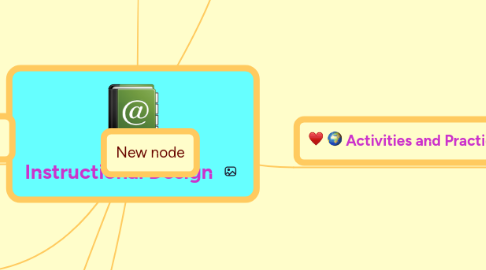
1. social context factors
1.1. Teachers knowledge,belief, theories of action
1.2. knowledge of context
1.3. knowledge of students
1.4. knowledge of curriculum
1.5. Pedagogical knowledge
1.6. knowlege of content
2. Definition
2.1. Set of events
2.2. Set of prescriptions
2.3. Set of procedural steps
3. New node
4. Learning Technology Design Trend
4.1. Web 2.0
4.1.1. learners as designer
4.1.2. collective design
4.2. mobile learning
4.2.1. multimedia access tool
4.2.2. connectivity tool
4.2.3. capture tool
4.2.4. analytical tool
4.2.5. representational tool
5. Examples
5.1. HKedCity Learning Objects
5.1.1. PBL(Problem-Based)
5.1.2. Rich resources
5.1.3. Novice learner
5.1.4. Good instructional design
5.2. Blog
5.2.1. Web 2.0 publication
5.2.2. Collaborative learning
5.2.3. Constructivism
5.3. RISAL@HKU
5.3.1. Collective design
5.3.2. An asset
6. Reflection and Recommendation
6.1. blended application
6.2. Consider situation
7. Activities and Practices
7.1. practices
7.1.1. procedures
7.1.2. media
7.2. activities
7.2.1. analysis
7.2.1.1. Initial analysis & feasibility study
7.2.1.1.1. Learner requirement analysis,
7.2.1.1.2. Audience analysis
7.2.1.1.3. Content analysis
7.2.1.1.4. Technology analysis
7.2.1.1.5. Environmental analysis
7.2.1.1.6. Human resource analysis
7.2.1.1.7. Cost analysis
7.2.1.2. Proposal
7.2.1.2.1. aim
7.2.1.2.2. content
7.2.2. Design
7.2.2.1. design approach
7.2.2.1.1. Direct instruction
7.2.2.1.2. Student-centred
7.2.2.2. knowledge,goals <=> strategies
7.2.2.2.1. Define goals
7.2.2.2.2. Learning Outcomes
7.2.2.2.3. Writing Learning outcomes/objective <=> goals
7.2.2.3. detail design
7.2.2.3.1. Analysis on
7.2.2.3.2. Consideration
7.2.2.3.3. Develop
7.2.3. development
7.2.4. implementation
7.2.4.1. Kolb Learning Cycle
7.2.4.1.1. learn from our experiences
7.2.5. evaluation
7.2.5.1. Reflection
7.2.5.2. Fourteen pedagogical dimensions of computer-based education (CBE)
7.2.5.3. By
7.2.5.3.1. Clients
7.2.5.3.2. Users
7.2.5.3.3. Team
7.2.6. management
